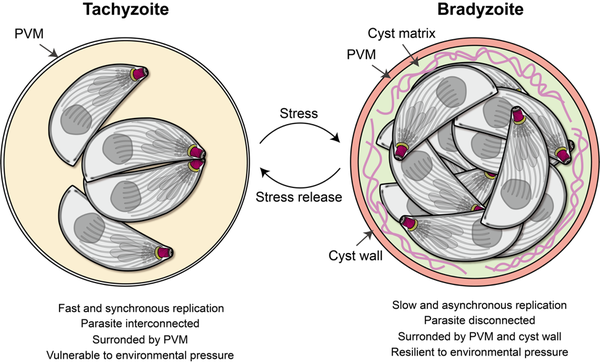Molecular mechanism of the survival and dissemination strategy of Toxoplasma gondii
Molecular mechanism of the survival and dissemination strategy of Toxoplasma gondii
Dr. Bingjian Ren
Apicomplexan parasites pose a significant global health challenge, impacting both humans and animals. Among these, Toxoplasma gondii has emerged as a prominent model organism since its discovery. This parasite exhibits the remarkable ability to infect nearly all nucleated cells, with a global prevalence affecting approximately one-third of the population. T. gondii is particularly amenable to cultivation and genetic manipulation, primarily due to its well-characterized lytic cycle.
A key feature contributing to T. gondii's widespread dissemination is its ability to transition between two distinct replicative stages: the rapid-replicating "tachyzoite" stage and the slow-replicating "bradyzoite" stage. This stage conversion can be triggered by external stress, leading to the formation of tissue cysts encased by cyst walls composed of protein complexes. The transition to bradyzoites underpins the establishment of chronic, lifelong infections, with cysts typically residing in neurons and muscle cells. While the tachyzoite stage has been extensively studied due to its ease of handling in cell culture, the bradyzoite stage remains relatively underexplored.

In our lab, we are particularly focused on the survival strategies employed by bradyzoites that enable their long-term persistence. One critical question we aim to address is whether bradyzoites eventually lyse residual cysts and leave the infected host cell to initiate a new round of infection. Insights from tachyzoite studies indicate that egress is tightly regulated by intracellular calcium levels, modulated through cGMP- and cAMP-dependent signaling pathways. Upon activation of these pathways, the parasite secretes micronemal proteins required for lysing the parasitophorous vacuole (PV) membrane, gliding motility, and subsequent host cell invasion.
The primary research questions driving our group’s efforts are:
- a) What molecular mechanisms enable bradyzoite survival?
- b) Do bradyzoites undergo egress, and if so, what are the signaling pathways and key factors involved?
- c) How does the parasite disseminate and persist after host uptake?
To address these questions, we employ a combination of genetic methods, large-scale screening, and detailed parasite phenotypic analysis in both in vitro and in vivo systems. Furthermore, we are committed to developing and optimizing super-resolution microscopy techniques to enhance our ability to visualize and study the parasite with greater precision.